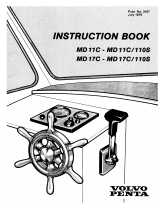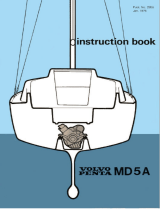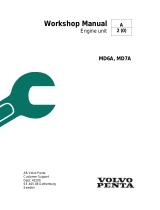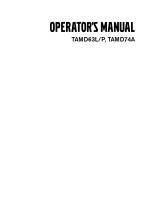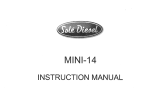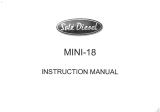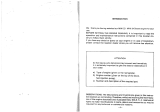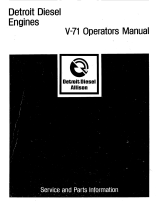Page is loading ...

Publ. No. 2505 B
Feb.1914
instruction
bool<
marine
carburetor
engine
MB
1OA

FOREWORD
Before
you
start using
your
new
Volvo
Penta
marine
engine,
we
recommend
you
to
read
this
instruction
book
carefully. lt
contains
all the instructions
you
need
to
run
and
service
your
engine
in
the best
possible
way.
The
dependabi
lity
and the lifetime
of
your
engine
and equipment
depend
to a
great
extent
on how
these units
are
given
service and
maintenance.
Always
closely fol
low
the instructions
included
ln
this
book.
Volvo Penta
has built
a world wide
service organization
including
service workshops
with
specially trained
personnel
at
your
service.
Always
contact
your
nearest Volvo Penta
representative
should
you
need
advice
and
also
when
you rsqLrile
se'vice or
pdrts.
We
are
fully
convinced
that
the
demands concerning
good
running
economy
and
outstanding
performance
you
have
every right
to make
on
a
high
quallty
product
such as this
will
be
more
than
satisfied and that
your
Volvo
Penta
will
provide you
with
a
lonq
period
of
faithf
ul
service.
GUARANTEE
Each
engine is
accompanied
by a warranty
certificate
which entitles
the first
purchaser
to a
guarantee
concerning
both materials
and Iabour.
The extent
of
the
guarantee
is
shown in the
warranty
card
and we recommend
you
to
read
this
caref
u I ly.
This certificate
contains
report
forms
which
are filled
in
by the
dealer and/or
boatbu
i lder.
lf our
guarantee
is
to be
valid,
we make one
absolute condition
and that is that the
checking
procedures
in the
maintenance
scheme are
carried out
and
that
your
engine
and its equipment
are
always looked
after
in accordance
with
the
instructions
in this
book. when
in
doubt,
please
always
contact
a Volvo
penta
authorized
dealer.
ln all correspondence
with
your
dealer and
also
when ordering
spare
parts,
always
state the type
designation
and serial number
of
the engine
and reverse
gear
(see
front
of
engine).
CONTENTS
Presentation
Running
the unit
I nstru mentation and
controls
GENERAL
INSTRUCTIONS
Fuel
and
lubricating
oil
recommendations
R un ni
ng-i n
Recommended
engine
speed
Precautions to
be
taken in case
of frost
.
RUNNING
Procedure
beforestartinS
. . . .
Starti
ng
Stopping
Technical description
Engine unit . .
Lubricating system
Fuel
system
Cooling system
Electrical
system
Wiring diagram
Reverse and
reduction
gear
.
4
4
4
5
5
5
o
7
1
7
8
a
I
10
Servicing
Maintenancescheme
......
.11
Periodical
servicing
12-16
General
servicing
instructions
17-24
Technical Data
Tracing
faults in case
of running
interruptions
25-26
..27

PRESENTATION
MBlOA
2-cvl.
-
15 h.p.
Fig.
1.
MB10A, with
MS reverse- and
reduction
gear,
starboard
side
Fig.
2.
MB10A,
with MS
reverse
gear, port
side
2
1. Distributor
2. Spark
plug
3.
Oilfilter
(Later
prod.)
4.
Oil
pressure
sender
5. Carburetor
with
flame
arrester
6.
Water-cooled ex-
haust manifold
7. Rocker arm cover
B. Sea-water
pump
9.
Oil dipstick, rever-
se
gear
1 0. Reduction/reverse
gear
l\,4S. ratio
1.91 : 1
1 1.
Starter-generator
1 2. Lifting eyelet
1 3. Thermostat and
water distributing
housing
14. lgnition coil
1 5.
Reverse
gear
MS,
ratio
1
I
1
16. Control arm for
reverse
gear
17.
Fuel
pump
with
hand
primer
18. Oil dipstick,
engine
INSTRUMENTATION
CONTROLS
RUNNING
THE UNIT
2.
1. Warning
lamp f
or
battery
charging
Red
light
-
no
charging
Switch
for extra electrical
equ
ipment
3. Key switch
with built-in star-
ter
4. Warning
lamp for oil
pressure
Red light
-
stop
engine, insuf-
ficient
oil
pressure
1. Control Iever
2.
l\eutral
throttle
knob.
Push
the button
when
the
control lever is
in neutral and
move the lever
forward
a
bit.
Release the
button.
The
gear
cannot be
engaged.
Push in
the button
again and
pull
back the
lever
for
synchroni-
zed
throttling
and shifting.
N
=
Neutral
position
F
-
Forward
posltion
R
=
Reverse
position
T
=
Throttle
.J
Fig.3.
lnstrument
panel,
MB10A
Fig
4. Combined
cortrol

RUNNING
THE UNIT
GENERAL
INSTRUCTIONS
FUEL AND LUBRICATING
OIL RECOMMENDATIONS
NOTE.
Our
guarantee
only applies on condition
that the following fuel
and
I u bricating
oi I
recommendations
are f ol lowed :
Fuel
quality
The engine is intended to
be
run on
petrol
with
an octane
rating of minimum
B0
ROT
(Research
Method).
Lubricating
oil
quality
Only
Multigrade
oil SAE 1O
W30
with
quality
designation
"For
Service SE"1)
is to
be used
for
lubricating
the engine and reverse
gear.
This oil contains additives
which
ensure
maximum lifetime for
the engine
and
reverse
gear
under different conditions
of operations.
RUNNING.IN
When
your
marine engine
is new, we recommend
that
you
run
it with a
certain
amount of care
during the first
20 hours of operation.
During this
time, never
subject the engine to full
loading for more
than
brief
periods,
because
it
is
during
this
period
that
the moving
parts
wear in together.
Oil changes
During
the running-in
period,
the engine
and
reverse
gear
lubricating oilshould be
changed more frequently
than
usual. Change the engine oil, reverse
gear
oil and the
oil
filter
after 20 hours of operation, see also under
"Servicing",
points
3 and
4.
RECOMMENDED
ENGINE
SPEED
lf
your
are
to
get
the very best
performance
from
your
boat, it is important that
the
propeller
is
selected so
that maximum engine
speed
is
reached
with a normally
loaded
boat. See under
"Technical
Data".
NOTE.
When the
boat
has
been in
the
water
for
some
considerable time, maximum
engine
speed can decrease if there is marine
growth
on
the bottom of the boat. Use
therefore
anti-fouling bottom
paint.
Check and clean the
bottom of the boat at
regular
intervals.
1)
Previous
designation
"For
Service
MS".
4
RUNNING
THE
UNIT
Precautions
to be
taken
in
case
of
frost
lf there
is
risk of
frost, drain
off the
cooling
water to
prevent
cracks in the
engine
block
and
reduction
gear
caused
by
the water
freezing. Note
the risk
of water
getting
into
the boat.
See
also
under
the
heading
"Procedure
to be
followed
when
laying
up
a boat"
(Page22).
RUNNING
Procedu
re bef ore
starting
1 .
Make
sure
that the
engine
compartment
is
well
ventilated'
2.
check
the
lubricating
oil
levels in
the
engine and
reverse
gear,
see
under
"Servicing",
points
1 and
2.
3.
Check
the
fuel level
in the tank
and open
the cock
for
fuel
supply to
the
engine-
At the same
time,
check all
fuel cocks,
pipelines
and screw
unions
for
leakage.
4.
Check
that the drain
cock
for the
cooling water is
closed.
Note.
The
drain
plug
for the
reduction
gear.
See
Fig. 22. Open
the bottom
cock
for the cooling
water
intake
(if
one is
fitted).
5. Switch
on the
master
switch
for
the
electrrcal
system
(if
one
is
fitted) and
pump
out
any
bilge
water
that may
have collected.
6.
Make sure
that
the
equipment on board
includes
a
fire extinguisher,
life vests,
anchor,
mooring
lines and
other safety
equipment.
Starting
1.
Move
the control
lever
to the
neutral
position
so
that the shift
mechanism
disengages.
See
the directions
given
in
Fig.
4.
Push
forward the
speed
control
to
approx.
1/4
throttle.
lf the
engine is cold,
the choke
must
be
completely
closed.
The
choke should
not
be
used when starting
a warm
engine.
2.
Turn the
key
switch
one step
to the
right. Check
that the warning
lamps for
battery
charging and
low oil
pressure
light up.
3.
Press
in the key switch
and
turn it
further to
the right,
this cutting
in the
starter-generator.
Release
the
key as soon
as
the
engine
starts.
Never race
a
cold
engine.
4. lf
the battery
is so
flat that
it is difficult
to
start
the
engine,
the
engine can
be
started
with
the
help of the
starting
crank
(available
as accessory).
5.
Check
immediately
after starting
that
the warning
lamps
for oil
pressure
and
battery
charging
have
gone
out.
Should
the
red oil warning
lamp
remain
on
-
stop the
engine
immediatelY.
6.
Check
the
cooling
water
circulation by
observing
that the
water
is
being
discharged
overboard.
Run the
engine warm
at
fast
idling
RPM.
Do not let the
engine
run with
the
choke
more than several
minutes and never
when the
engine is completely
warm.
1.
Move the
control
lever to neutral
in order
to engage the
shift
mechanlsm
(see
Fig. 4).
The
boat
is now ready
for operation.

RUNNING THE UNIT
Stopping
1.
Move the control
lever to neutral
position
and let the engine
run
some
minutes
at idling
speed before stopping it.
2.
Turn the key
switch
to neutral
position
when the engine has
stopped.
NOTE.
The
master switch must never be switched
off before the engine has completely
stopped.
3. Switch
off
the
master
switch
(if
fitted)
and close
the
fuel
and
cooling
water
cocks if the unit is to remain idle
for
some considerable time.
4.
lf
the unit is
to remain
idle
for
more than two weeks,
special
inhibiting
measures must be taken with the engine
(see
under
"Procedure
if
unit is to
remain idle").
lf the engine has electrical equipment, this equipment
should be sprayed
regularly
with
f luid which
protects
agalnst corrosion and moisture.
TECHNICAL DESCRIPTION
TECHNICAL
DESCRIPTION
ENGINE UNIT
The MBl0A is a
2-cylinder,4-stroke
petrol
engine,
specially constructed
for
marine
use.
The
cylinder block
and crankcase are made in one
piece.
The
crankcase is
provided
with a bottom
cover. The cylinder
bores,
which are
surrounded
by cooling
jackets,
are drilled directly
in the
cylinder
block.
The crankshaft is
carried in
two
main
bearings.
The
bearing shells are
replaceable
and have
bearing
metal of
indium-plated lead-bronze.
LUBRICATING
SYSTEM
The engine is
fitted
with a complete
pressure
lubricating
system.
The oil filter is of
the full-flow
type and is replaceable
as a unit.
lt is
provided
with an overf low valve.
The lubricating system
has
a
relief valve which
prevents
the oil
pressure
from
reachi n
g
excessive val ues.
FUEL SYSTEM
The engine
fuel
system
consists of a
fuel
pump,
carburetor
with
flame
arrester,
intake manifold and
fuel lines.
The fuel
pump
is of the diaphragm
type and is actuated
by
a cam on the engine
camshaft. A hand
priming
device
on the
feed
pump
makes it
possible
to
pump
the
fuel even when
the engine is stopped.
Fig.
6.
Longitudinal section of
engine
Fig.
5. Cross-section
of
engine

TECHNICAL DESCRIPTION
COOLING
SYSTEM
The
engine and
reduction
gear
are sea-water
cooled
and
the system
is
fitted with a
thermoitat
which
controls
the
temperature
of the
engine"
Cooling
water circulation
is taken
care of by
means
of
a
sea-water
pump
mounted
on
the
timing
gear
housing.
The
pump
is
driven
from the
camshaft
through
a
flange.
The
pump
impel
ler is made
of
neoprene
rubber
and
operates
against
a
cam.
The
pumpsucks cooling water
from
the
sea through
the
water intake.
The
water
is then
forced under
pressure
through
the
exhaust
manifold
cool
ing
iackets
and
fi
lls
the
engine
water
channels.
On
top of
the
engine
there
is a water
distributing
housing
provided
with
a
thermostat.
When the
engine
is cold,
the cooling
channels
in the
engine and
exhaust
manifold
are
filled with
cooling water
which
is
rapidly
heated up.
when the
thermostat
is closed,
the surplus
water
passes
through
the distributing
housing
and
on to
the water-cooled
exhaust
elbow
where
it mixes with
the
exhaust
gases
or
is
conveyed
overboard,
depending
on
whether
a wet or dry
exhaust line
has been
i nsta I led.
The
cooling water
in the
engine
cooling channels
is
rapidly
heated up and
this
causes
the thermostat
to open
and
force the
cooling
water to
pass
the
engine
cooling
channels before
it enters
the
exhaust
elbow. Thethermostat
thus regulates
the
cooling water
circulation
so
that
the
engine always
has
the right
temperature
irrespective
of the
size
of the
engine
load.
Fig.
7. Setting
the two-way
cock
for outgoing
cooling water
The
cock
can be
locked in
the
desired
position
with
a screw, see
arrows
A
= Setting
with drY
exhaust
line
B
=
Setting
with
wet
exhaust
line
ELECTRICAL
SYSTEM
The
electrical
system
has a
voltage
of 12
volts and
is
designed
specially
for marine
USC.
The
engine is
equipped with
a
starter-generator,
which
means
that
the
generator
and
starter
motor are combined
and
are driven
by
vee-belts
from the engine
f
lywheel.
I
TECHNICAL
DESCRIPTION
Warning!
The
following
applies
to
an
engine fitted
with alternator and master
switch:
Never break the circuit between the alternator and
battery while
the engine
is running. To
do
this would be to ruin the charging regulator immediately.
Do not
switch off
the master switch until the engine has
stopped. See
also
under
"Servicing",
point
16.
Wiring diagram,
MB10A
Cable marking
Mark Colour sq.mm.
AWG
15
13
15
o
13
I
5
15
t5
4E
I N5IRUMENI
IN5TRUiltNT
Black i.5
Black 2.5
lvory i.5
lvory 6
Red 2.5
Red
6
Red 16
Brown 1.5
Green 1.5
Blue 1-5
B
A
Fiq.8.
Wiring diagram,
MBl0Awith
Sl
BA starter
generator.
Components
1. Key switch
2. Warning lamp f or
"low
oil
pressure'
3. Battery
charging warning lamp
4. Switch {extra)
5. Connection terminal
6. Connection
terminal
l. Battery
8.
9.
10.
11.
12.
13.
14.
Master
switch
Starter-generator
Charging
regulator
Fuse
Oil
pressure
sensor
lgnition coil
Distributor
I

TECHNICAL
DESCRIPTION
Fig
9.
Wiring diagrams,
MB10A
with Bosch
starter
generator
1.
Key
switch
with star-
7. Oil
pressure
sender
PERIODICAL SERVICING
MAINTENANCE
SCHEME
The
numbers of the servicing
procedures
below
refer to the detailed descriptions
on
the
following
pages.
Some
of these
operations require specialized
mechanical
knowledge and
the use of special
tools. For this
reason,
these
operations
should
be
carried
out
by
an authorized service
workshop.
1
)
Or
once each
season
should this occur
first
2) Daily bef ore starting
for f irst time
3)
Every other
year
or when engine is
taken
out of boat
4) Change
the oil
filter
after every 100 hours running or once each season
ter co
ntact
2. Extra switch
3.
Battery
charging
war
ning lamp
4. Oil
pressure
warning
12.
Fuse
8.
lgnitlon
coil
9. Distributor
1 0.
Starter
generator
1 1. Cable
harness
13. Charging
regulator
14. Battery
15.
Master
switch
lamp
5.
Connector
6. Connector
6
Reverse
gear,
type Mono
Shift
(MS)
The Volvo
Penta reverse
gear,
type Mono Shift, has a
ratio of
i:1
and, as
alternative,
a
reduction
gear
wlth reduction ratio
1.91:1.
The
reduction
gear
is
integrally built with
the reverse
gear.
Power is transmitted
f rom
the
engine to reverse
gear
through a
rubber f
lange.
For manoeuvering
"Forward"
and
"Reverse",
the
Volvo Penta
patented
cone
clutch
is used. With
this type of clutch, engagement is both smooth and
quiet.
Very
little
force
is
required
to operate the
reverse
gear.
The
engaging
power
of the cone clutch
is influenced by the size of
the
power
transmission
torque. The
greater
the torque, the stiffer will be the clutch
engagement
with increased
throttling.
10
See
point
Operation
Every
14
days
Afterl
)
50 hours
ru nni ng
Afterl)
1
0O
hours
runni
ng
PERIODICAL
SERVICING
Check oil
level
in engine
azl
2
Check oil level in reverse
gear
azl
.t- Change oil
in engine and change oil filter
.4)
4.
Chanqe oil in reverse
and reduction
qear
a
5. Clean oil strainer
3)
6.
Clean air cleaner
o
1. Check vee-belts
a
8.
Check valve clearances
o
9.
Check and clean fuel filter
a
'1
0. Check battery
electrolyte
level
o
11
Check
and
chanqe
spark
plugs
a
GENERAL SERVICING
INSTRUCTIONS
To be carried out
according
to the inter-
vals
given
under
respect-
tive
points
or when
necessary
12.
Check-tighten cylinder
head
bolts
13. lgnition timing and distributor
14. Adjust
carburetor
i5. Cooling system
i6.
Electrical
system
11
.
Check
reverse and
reduction
gear
18.
Procedure if unit
is
to
remain idle and
i nhi biti ng
11

PERIODICAL
SERVICING
1.
Checking
oil
level
in engine
Check
the oil
level
in the engine
daily before
starting
for the
f
irst time.
The
dipstick
is
located
on
the
port
side
of the
engine
and
has upper and
lower
markings.
The oil
level
must never be
allowed
to
go
down
below
the
lower
mark and
it
should
not
be
above
the
upper
mark since
this
can
result in abnormally
high oil
consumptlon.
Remove
the dipstick
plug
(see
Fig. 12\ to
fill
with
oil. Concerning
the
oil
quality
and
viscosity, see
point
3.
Fig. 10. Checking
engine oil level
Fig. 11.
Checking
reverse
gear
oil
level
1.
Oil
f illing
2.
Dipstick
2.
Checking
oil level
in reverse and
reduction
gear
The
MS reverse anh
reduction
gear
has a
separate oil
compartment.
Check the
oil
level daily
before starting
for the
first time
with
the
help of the dipstick
which
is
located
on
the starboard
side of
the
reverse
gear.
The
oil
level should
be
between
the
max. min. marks
on the dipstick
(which
must
not
be Screwed
down when
measuring
the
oil
level). When necessary,
top up
with new oil
(see
1,
Fig. 11). Concerning
the
oil
quality
and
viscosity, see
point
4.
3.
Changing
the
engine oil and
oil filter
Change
the
lubricating oil
after every
50 hours
running
or at
least once
each
season.
During
the
running-in
period
the oil should
be
changed after 20
hours of
operation.
Run
the engine warm
before
changing
oil.
The oil issucked
upfromthe'crankcase
with the
help
of a scavenging
pump,
the tube of
which
rs
inserted
through
the dip-
srick
hole. The scavenging
pump
is supplied
with the tool
kit.
Oil
is added
to
the
enqine
afterremoval
of the
plug
through
which the dipstick
is tnserted,
see
Fig. 12a.
Concerning
the
oil
quality
and
viscosity, see
the table.
12
PERIODICAL
SERVICING
Change
the oil
filter after every
100 hours
running
at the same
time as the
oil is
changed.
ln the case of
a new or
reconditioned
engine, the
oil filter should also be
changed
for the
fi
rst time after
20
hours running
(see
"Running-in
the engine").
The oil
filter is changed
as
fol lows:
Unscrew
the old
filter
(see
Fig
12bl .lf
it
remains firmly in
position
and cannot
be
loosened,
use
a
special tensioning
tool or
pierce
the outer
part
of
the
filter
with
a
screwdriver
that
can be used
as a lever.
Remember that
oil can spill
out.
Make sure that
the contact surface
against
the
engine
block
is
clean. Smear the
new
filter
rubber
gasket
with
oil and screw
on the
fi lter
by
hand
until it
just
comes into
contact
with the
contact surface
of the
engine block.
Tighten
the
{ilter a further
half turn but
no
more.
Start
the
engine and
run it at
idling speed
while
checking to
make sure
there is
no leakage at the
filter.
Always check
the oil
level
after
changing
the oll
filter or changing
the
engine oil.
Quality
Viscosity
Multigrade oil
Oil
capacity,
litres
(lmp.
qts.
=
US
qts.)
Excl. oil
filter
I
lncl.
filter
Service SEl
)
SAE 1OW/30 approx.
1 .5
(1
.3
=
1 .6) 1.75
(1
55
=
1.85)
1)
Previous designation
Service
MS
$m
:&
,lk-"
::
;
\
I
s
(
F
å
Gl--
tt
æ;,"-,!'
I
Fig. 10. Checking
engine oil level
Fig.
12a.
Hole for oil fi lling
Fi
g.
1 2b. Oi
I f ilter
13

PERIODICAL
SERVICING
4.
Changing
oil in
reverse
gear
and
reduction
gear
Change
the
lubricating oil
in the reverse
gear
and reduction
gear
after every 50
hours
running or at
least once
each
season.
During
the
running-in
period
the oil
should
be
changed after
20 hours of
operation.
The
oil
is drained through the
reverse
gear
drain
hole or is
sucked
up with the help
of an oil scavenging
pump
through
the hole
for
the dipstick.
When adding oil,
f ill up
to the upper
mark on the oil dipstick, see
table below.
I
PERIODICAL
SERVICING
Fig. 13. Cleaning
air cleaner, arrow
Fig. 14. Checking
belt
tension
shows
lock
screwl
)
Test the belt
tensioning by
pressing
in
the belts
midway between
the starter-genera-
tor and
flywheel. lt should
be
possible
to
press
them in
about 3-4
mm
(1/8")
under
normal
thumb
pressure,
see
Fig.
14.
lf
an alternator
is
fitted, the vee-belt
tension
should be
so hard that
it
is
just
possible
to
get
the
pulley
to slip by
turning with
one
finger a wing on
the alternator
fa n.
lf the belt
is insufficiently
tensioned,
loosen the tensioner
arm as
well as
the
bolts
at
the alternator
attaching
points.
Tension
the belt by
moving the alternator
outwards and
re-tigh.ten
the screws.
8.
Ghecking
valve
clearances
Check
the
engine
valve clearances
after
every 100
hours running
or at
least once
each
season.
Concerning
valve
clearances, see
under
"Technical
Data".
Any valve
adjustment
wlll involve
grinding
valve stem
ends
and
seats
and
for this
reason
this
should
be
carried
out
by
an authorized
Volvo
Penta
service
workshop'
9.
Checking
and cleaning
fuel
filter
The fuel
filter should be
cleaned
after
every 50 hours
running
or
at least once
each
season.
Wash the outside
of the
fuel
pump
clean and
remove the
cover and
fuel
filter,
see
Fig.
15.
Clean the
filter
and
re-fit
it, with the
pins
facing upwards. Check
the
packing
and re-fit
the cover.
Pump
forward
fuel
with
the hand
primer
and
carefully
check
to
make
sure
that
the
gasket
does
not
leak. lf the
pumping
effect is
poor,
turn
over the
engine a bit
so that the
fuel
pump
drive
cam
alters
its
position.
lf an
oil
quality
Viscosity
Multigrade oil
Oil capacity
litres
(lmp.
qts.
=
US
qts.)
excl.
red.
gear
I
incl. red.
gear
min. I
rna*.
lmin. I
max.
Service SE1
)
SAE 1OW/30
0.35
(0.31
=
0.37
)
0.45
(0.40
=
0.48)
0.50
(o.44
=
0.53)
0.60
(0.53
=
0.64)
1)
Previous
designation
"Service
MS"
5.
Cleaning
the
oil strainer
An oil strainer
is
built
into the
engine
bottom
cover.
The oil strainer should be
cleaned in white spirit
at least
every other
year
or when
the engine
is
taken
out of
the
boat.
Use
a new
gasket
for the
bottom
cover and
check
for leakage after
filling
with oil.
6.
Cleaning
the air cleaner
The air cleaner should be
removed and cleaned
after every 100 hours
running,
or
once
each
season.
1.
Release the lock screw
with a screwdriver
and remove the cleaner. See
Fig.
13.
2.
Clean the
air
cleaner in white spirit and soak
it in engine
oil.
3.
Allow
the
engine
oil
to run off and
re-fit the cleaner.
7.
Checking
the
vee-belts
Check the
vee-belttension afterevery 50 hours
running.
The
belts
can
start slipping
due to wear or
grease.
14
I
ll
1) Late
prod.
type
provided
with clanrp
15

PERIODICAL
SERVICING
extra fuel filter
with water separator is fitted
(Fig.
15), the
transparent container
should
be
checked for
any water in
the
fuel.
The
water can
be removed
through
the
Qrain
cock in the
bottom of the filter
container.
Look out for fuel
splash. The filter
element
should
be
changed
at
least
once each
season.
',*
æ., \,
Itlkail
\
Fis.
15.
Cleaning fuel f
ilter
Extra
fuel filter
with
water separa-
tor
10.
Checking electrolyte level
in battery
Check
the
battery
electrolyte level
at
least
every 14
days.
The level
should
be
between 5 and 10 mm
(1
14
and 112"1 over
the
cell
plates.
Add
distilled water
whenever
necessary.
Never add
too
much
since the electrolyte
can then
splash out
and cause corrosion
damage. Never check the electrolyte
level
by
using
a
lighted
match
since
gas
formed
in
the battery cells is
highly
explosive.
11.
Checking
and
changing
the spark
plugs
Check the
spark
plug
gap
and
wear at least
after every
50 hours
of operation. The
electrode
gap
should
be 0.7
mm
(0.028")
and this must
be checked
by using
a
wire
type
gauge.
lf
the
electrodes are
burnt
or
the insulation
damaged, the
plugs
must be
replaced
immediately. lf
necessary,
clean the
plugs
with
a
wire
brush. Make
sure
that
you
always
get
the right
type of
spark
plugs
with the
correct heat range
and
also that
the
plugs
are tightened
to the correct
torque.
(See
Technical
Data.)
to
SERVICING
GENERAL SERVICING
INSTRUCTIONS
12.
Check-tightening
cylinder
head bolts
With a new
engine or when
the cylinder
head has
been removed, the
cylinder head
bolts
should be
re-tightened after
20 hours
running.
Check-tightening
of the bolts
should
also be
carried out
once
each
season
and always
with
a
torque
wrench.
Concerning
tightening
torque, see
"Technical
Data".
Fig.
16.
Tightening
sequence
for
cylinder head bolts
13.
lgnition
timing
and distributor
All
adjusting
work
on the engine ignition system
should be
carried out by a service
workshop with
the
special
equipment
required
for
this
purpose.
The ignition system
is one
of the most sensitive
parts
of
the engine and interference
here immediately
leads
to decreased
engine
output, high fuel consumption
and, in the
worst cases,
serious
engine damage.
The ignition
timing and the distributor
should be checked
once
each
season.
IGNITION TIMING
The ignition
timing
is checked
only with the help of a stroboscope
at the speeds
specified
in
the Technical
Data On
the oil
pump
housing there
is a notch and on
the
flywheel
timing marks,
see
Fig.
'1
7.
@
o
o@
11

SERVICING
DISTRIBUTOR
Check the contact
breaker
points
which must not
be burned on the contact
surfaces.
Turn
the
engine
over
until the
breaker
points
are
fully
open
and check the
breaker
gap,
A
in Fig.
18, which should
be
0.4 mm
(0.016").
Make
sure that the
contacts
are
correctly located vertically
so
that the faces
are completely
opposite
each other. The
gap
can be adjusted
by
turning the
fixed
contact
(2,
Fig.18),
after
the
lock
screw
for
the attaching
plate
has
been slackened.
Lubricate the
distributor
with a
few
drops of
engine
oil in the
drive shaft
lubricating wick
(i)
under
the
rotor. Lubricate
also with oil the lubricator
(3)
under
the
distributor.
lnspect the distributor cap
for
cracks and clean all contact
surfaces thoroughly.
Check
that the center
contact
stud
is
not
loose
and
is
not
worn. See
Fig.
19.
Fig. 18. Distributor, adjusting breaker
contacts
-)
Fig. 17.
Timinq
marks
1B
Fig. 19. Distributor,
checklng contact surfaces
19
SERVICING
14.
Adjusting
the carburetor
The
carburetor should
be checked
and adjusted
by an
authorized
Volvo
Penta
service
workshop.
Adjusting the idling speed
1.
Check
when the throttle
control
is in neutral
position
that the connecting
sleeve
of the control cable
has a clearance
of
1.5
mm
\1
116"1
(A,
Fig.20)
on
each
side
of
the
"dice".
Adiustments
can be
made
partly
with
the carburetor
lever
and
partly
with the control
lever.
2.
Run the
engine warm and check
the
idling
speed, see
under
"Technical
Data".
Adjust
the
idling
screw
(1,
Fig.
20)
when necessary.
lf
the engine
runs
unevenly,
adjust the air screw
(2)
until
even
running is obtained.
Check to
make sure
that
the connection sleeve
for
the control
cable has the
proper
clearance
according
to
point
1.
Fig. 20. Carburetor, Solex 26VBN2
'1
.
ld ling screw
2. Air screw
A
=
1.5 mm
(1/16")
15.
Cooling system
The
cooling
system
slroLrld
lxt
clrrtckr:d
regularly
for leakage, deposits,
etc.
The thermostat
can be
insJ-rcclt:d
aftt:r thc
water distributor
housing
has been
removed.

SERVICING
REPLACING
THE SEA.WATER
PUMP IMPELLER
The
pump
impeller
is made
of neoprene rubber
and this
can be damaged
in the case
of water
deficiency
caused by, for example,
blocking
of the
sea-water inlet. The
pump
impeller is changed
as
fol
lows:
1.
Close the
bottom cock.
Remove the
cover
from
the
sea-water
pump.
Note the
risk
of water
getting
into
the boat.
With the
help of two
screwdrivers
pullthe
shaft
with the
pump
impeller
out of the
housing as far
as
necessary
in
order
to
reach the
bolt
retaining
the impeller.
See Fig
21.
NOTE. Place
some
kind
of
protection
under the
screwdrivers in order
not to damage
the impeller
housing.
2.
Pull
the impeller off
the shaft. Clean the inside
of the
pump
housing
and
fit
the
new impeller.
3. Fit the cover
with its original
gasket
which has the right
thickness. Always
have
a
spare impeller on board.
Open the bottom
cock.
Fig.21
.
Removing
impeller.
Arrow
points
to impeller
lock bolt
16.
Electrical
system
CHECKING THE
STATE OF CHARGE
OF THE BATTERY
The
state of charge of
the battery
should be checked at least once each
season.
This
is done by using a
hydrometer which
shows the specific
gravity
of the electrolyte,
this varying
with the state of charge.
(See
under
"Technical
Data".)
CABLES AND CABLE TERMINALS
At regular
intervals check that all
cable terminals are
properly
tightened and that
none
of the
cables
is
damaged.
STARTE
R-GENERATOR
All work on the
starter-generator
(and
alternator
lf
fitted)
should be carried out by
an authorized
service
workshop.
lnspection and control
should be done when the
engine
is
given
a
qeneral
overhaul.
20
SERVICING
NOTE. This is
particularly
important when
the engine is
fitted with an alternator.
The battery
poles
and
cable clamps should be
well tightened and smeared
with
grease
or
vaseline.
WARNING!
lf the alternator
and its regulator are
to
function
perfectly,
it is extremely
important
that the
following instructions
are followed:
1.
Never break
the circuit between
the alternator and
battery
while the engine
is
running. The
result will be a short-circuit
in the
regulatorwhich
is immediately
ru ined.
The master switch
must never
be switched
off before
the engine
has completely
stopped.
2.
Never confuse
the battery
poles
with
one another.
The
poles
are
generally
stamped
with a
plus
and a
minus sign
respectively.
The minus
pole
must always
be
earthed to
the engine block.
3.
Use only
Volvo
Penta double
diode
kits when charging
two
batteries
from one
generator.
4.
ln the case
of
starting
by
using a spare
battery,
this should
be done
as
follows:
Let
the
ordinary battery
remain
connected
in circuit.
Connect
the
spare
battery
to the
ordinary battery,
plus
to
plus
and
minus to
minus. When
the
englne starts
disconnect
the spare
battery
but never
break
the circuit to
the
ordinary batlery.
Never use a
rapid charger while
the alternator
is connected
to
the battery.
Always disconnect
both
battery
cables before
carrying
out any
work on
the
alternator
equipment.
7. lf
electric
welding work
is to be carried
out
on the engine
or installation units,
disconnect
the charging
regulator
cables at
the alternator
and insulate.
8.
Check
vee-belt tension and
cable
connections at
regular intervals.
17.
Ghecking
the
reverse
gear
and
reduction
gear
The
reverse
gear
and
reduction
gear
should be
checked regularly
for
oil leakage,
abnormal
noise or excessive
operatinq temperature.
When
remote
control
is connected,
it must be so designed
that there
is
no
constant
pressure
on the control
components
of the reverse
gear.
When
reverse
gear
is
enga-
ged
for
"Forward"
or
"Reverse",
the
remote
control should be
completely off-
loaded.
Adjust if
necessary by loosening
the lock
nut
and turning
the cable
"dice".
5.
6.
21

SERVICING
18.
Procedure
if
unit is to remain idle
IDLE PERIOD WITH BOAT AFLOAT
ln
case
of
an idle
period
of
less than one
month
with the
boat afloat, the engine
should be
started and
run
warm
after
at least every
14 days
to
prevent
corrosion
damage to
the internal
parts
of
the engine.
lf
the engine is to remain
idle
for
a longer
period
than one month,
then
the
engine
should be inhibited,
see
under
"Procedure
before laying up"
Protect
the engine
and equipment from external
corrosion
damage by regularly
spraying unpainted
surfaces and electrical
components with corrosion
and moisture
protection
spray.
We also recommencl
that the
cylinders are
sprayed through the
spark
plug
holes in
the case
of
longer intervals of
idleness.
PROCEDURE
BEFORE LAYING UP
Before the boat is taken
up on land for
laying up, it
is advisable to let an
authorized
service
workshop
test the engine
and reverse
gear.
lt is also
advisable to carry out a
compression test on the
engine.
PREPARE THE
ENGINE
FOR LAYING UP BEFORE
THE BOAT IS
LIFTED
OUT OF THE
WATEB AS
FOLLOWS:
1. Run the engine
warm,
stop it and
pump
all the lubricating oil
out of the engine
and
reverse
gear
with the
help
of
the
scavening
pump.
2.
Fill
up the engine
and
reverse
gear
with
inhibiting
oil to the lowest mark
on the
dlpstick. Suitable inhibiting
oils are Esso
Rust Ban
623, Shell
Ensis
Oil20
or
corresponding oils of
another make.
3. Run the engine off-load for
about
5 minutes.
AFTER
THE
BOAT HAS BEEN LIFTED
ASHORE,
CARRV OUT THE FOLLOWING
PROCEDURE:
1.
lnhibit
the cooling
system
as follows:
a.
Drain off all cool
ing water
from
the
engine
and exhaust manifold
by
opening the
drain
cock
(on
the
starboard side) and from
the reduction
gear
by opening the
drain
plug,
see
Fig.
22.
Then
close the cock and
drain
plug.
b.
Mix rustproofing
agent in
a
container filled
with at least 20 litres
(3
1/2
lmp.
galls.
-
4112 US
galls.)
of fresh
water. The
rustproofing
agent used
should
be of the emulsifying type, for example, Esso
Cutwell 40,
Shell
Donax C or
similar.
Add
20 %
rustproofing
oil to the water and stir well.
NOTE. Always add the oil to the water and never the other way
around.
22
SERVICING
c. Disconnect
the
suction
line
between
the cooling water
pump
and bottom
intake
from the
pump.
When a
reduction
gear
is
f
itted to
the reverse
gear,
disconnect the suction line between
the
reduction
gear
and
the
bottom
intake
from
Lhe
reduction
gear.
d.
lnstead connect a
112"
rubber
hose, the
length of which
should
be
sufficient
to
reach down to the bottom
of the containerwith
rustproofing
m
ixtu
re.
e. lnsert the connected suction
hose into the container. Start
the engine and
let it run at idling until the
water has been
sucked
out of the contatner,
this
forming a
protective
oil film in all the cooling channels.
NOTE. Never
let the engine run dry since
this can damage the cooling water impeller.
Then
connect
the coolinct water
hose.
f. Drain all cooling
water
from
the
engine
by opening the drain cock, see
Fig.
22. The rustproofing mixture does not
protect
the engine against
frost.
lf the
engine is fitted with a wet exhaust line, this should also be
drained of water. When a
reduction
gear
is
fitted, this
should be drained
of
cooling water through the
plug
in the bottom of the reduction
gear.
S.
Drain
the cooling water
pump
by
removing the
pump
cover. Take
out the
impeller
(see
under
"Servicing",
point
15)
forwinter
storage.
Let
the drive
shaft
remain in
position
and
re-f it the
cover.
Remove the
spark
plug
and spray
each cylinder with inhibiting
oil. Then turn
over the
engine
several
turns before
re-fitting
the spark
plugs.
Fig.22.
Drain cock
for
cooling water,
engine
1.
Dr,rin,.ock
fr'r
(
ooling water, engine
2.
Drain
pluq
for oooling water, reduction
gear
LJ

J-
4.
SERVICING
Clean the outside of the engine
and
reverse
gear
with white
spirit
or
similar
and
touch up
damaged
paintwork.
Protect
all
unpainted
parts
and the electrical
system by
spraying
them with
corrosion and moisture
protective
spray.
Bemove
the
battery and
put
it into
storage. lt must be
re-charged
at
regular
intervals if it ls to
be
kept in
good
condition.
PROCEDURE WHEN LAUNCHING
1.
Pump
out
all
the rustproofing
oil from
the engine
and
reverse
gear,
see unCer
"Servicing",
points
3 and 4.
2.
Fill the engine
and
reverse
gear
with
lubricating oil,
see under
"Servicing",
points
3
and 4.
3.
Fit
the
pump
impeller in
the cooling water
pump,
see under
"Servicing",
point
15, and
connect all hoses and check-tighten
the hose clamps.
Clean the outside of the engine
and
reverse
gear
of rustproofing
oil and
adjust
the operating controls.
Take a
fully
charged
battery
on
board
and connect up the
battery cables.
NOTE.
Be careful not to confuse the
cables
(see
under
"Servicing", point
16).
The
negative battery
pole
should be
earthed
to
the engine.
Grease in the
battery
cable
clamps with
grease
or vaseline
before tightening.
Remove the
spark
plugs
and
turn over the engine
several turns with the
starter-
generator
in order to blow out any rustproofing
oil which may be on
the
tops of the
pistons.
NOTE.
Prevent
oil
splash.
Re-fit the
spark
plugs,
see
under
"Technical
Data"
for
their tightening torque.
CIose the drain cock
for
the cooling system. Note. The
plug
for
the
reduction
gear.
Open the bottom cock
for
the
cooling
water intake.
Launch the
boat
and fill the fuel tank. Clean
the
fuel filter
(see
point
9) and
pump
forward fuel with the help of
the hand
primer.
Check thoroughly the
tank,
lines,
connections and cocks to be
absolutely sure
that
there is no
leakage.
Start
the engine and follow carefully the
running
instructions
given
on
pages
5*6. Run the
engine
warm with the reverse
gear
engaged. Check
to make
sure
there is
no leakage
of
fuel,
water, oil, air or exhaust
gases.
lf there is,
attend to
it immediately. Check the bolts and nuts
for
tightness.
Contact an authorized Volvo Penta
service workshop and have servicing of the
engine and
reverse
gear
carried out as specified in the maintenance scheme.
4.
5.
6.
8.
9.
10.
14
25
TECHNICAL DATA
General
Type desingation
Max. output,
h.p.
Max. speed,
r.p.m.
Number
of cylinders
Type of operation
Displacement,
cc
(cu.
in.
)
Bore mm
(in.)
Stroke,
mm
{in.)
. .
Compression
ratio
Compression
pressure
({ully
open throttle), speed,
kp/cm2
(p.s.i.)
. . .
ldling
speed,
r.p.m
Total
weight, approx.
kg
(lb.),
engine
+
reverse
gear
Max.
inclination of
enqine in boat
underway
Valves
Valve clearances,
warm
enginel
)
lnlet
valve, mm
{in.)
Exhaust valve,
mm
(in.)
Valve
clearances,
cold
enginel
i
lnlet valve,
mm
(in.)
Exhaust
valve, mm
(in.)
Reverse
gear
Type designa
t ion
Ratio
"Forward"
and
"Reverse
Ralio with auxiliarV
gear
Lubricating system
Engine
Oil
quality
V iscosity
Oil
capacity,
engine, litres
(lmp.
qts.
=
US
qts.),
approx.
excl.
filter
incl.
filter
Oil
pressure,
warm engine,
idling speed,
tp/cm2
(p.s.i.)
at full speed,
kp/cm2
{p.s.i.)
Reverse
gear
Oil
quality/Viscosity
Oil
capacity.
litrer
(lmp.
qt.
=
US
qt.)
. . .
Oilcapacity
with auxiliary
gear,
litre
(lmp.
qt.
=
USqt.)
1
)
Adjustment
is carriåd
out
bv
grinding
valve stem
ends and
seats
2)
Previous
desiqnation
"service
MS"
MBiOA
15
2000
2
in-line
Side-valve,
4-stroke
carburetor
engine
1018
{62.1 )
88.9
(3.50)
82
(3.23\
6.5:1
7.5
1101\
600
1 15
(253)
1Bo
.
o.35
(0.014)
0.30 {0.012)
0.35
(0.014)
0.45
(0.018)
Volvo Penta MS
1.1
1 91:'1
l\/lultigrade
oll
Service SE2)
SAE
1OW/30
1.5
(1.3
=
1.6)
1.75
(1.55
=
1.85)
1-2
r4-28)
4
l51l
Same
as engine
0.4
(0.35
=
0.42)
0.55
(o.48
=
O.5B)

SERVICING
Fuel system
Carburetor, Solex
type
26 VBN2
Main
jet
102.5
ldling
iet
45
Float valve
1.2
Fuel
pump
feed
pressure,
kplcm2
(p.s.i.)
.
o.2
(3)
Petrol
grade
Octane
rating
ROT,
min.
lgnition
system
Cylinder
marking
1 nearest f lywheel
Spark
plugs,
Bosch type
W175T35
(alt.
correspondi ng
spark
plug
of
other
make)
Gap,
mm
(in.)
. .
0.7
(0.028)
Early
prod.
Distributor, Bosch type
80
ing,
1200
r.p.m
Cam angle
Late
prod.
Distributor, Bosch type
JF2O231 109 015
Basic setting
20
(before
T.D.C.)
Stroboscope setting,
12OO
r.p.m.
1 10
Gap, mm
(in.)
.
.
0.4
(0.016)
Cam angle
600
a
30
Electrical system
Voltage, volts
12
Battery
capacity, Ah max.
(SIBA
STARTER
GENERATOR)
34
Battery
capacity, Ah max.
(BOSCH
STARTER GENERATOR)
60
Battery
electrolyte specif
ic
gravity:
Fully charged battery,
9/cm3
. .
Battery
to be re-charged
at
g/cm3
Starter-generator,
type
S
iba
Generatoroutput,W
,..
.,.....
60
starter
motor
output, h.p.
0.8
Starter-generator,
type
Bosch LA/Ej
90/2900
Generator output, W
. . .
135
max.
9O kont
Starter
motor output,
h.p.
1
Basic setting
Stroboscope sett
Gap, mm
(in.)
Tightening
torques
Cylinder bolts,
kpm
(lb.ft.)
Spark
plugs,
kpm
{lb.ft.)
Flywheel
(nut),
kpm
(lb.ft.)
Connecting
rod nuts, kpm
(lb.ft.)
,/6
JF20231 109 014
30 after
T-D.C.
oao
0.4
(0.016)
600
t
30
1.275*1 .285
1.230
DS418
8.3
(60)
3.8
127.51
38
12151
5.5
(40)
TRACING
FAULTS IN CASE OF RUNNING
INTERRUPTIONS
The
fault-tracing scheme
below
includes only the
more usual
reasons for faulty
operation.
With the help
of the instructions
given
in this book
it is usually
possible
to trace most
of the causes
mentioned
below. ln case of doubt
always contact
the
nearest Volvo
Penta
service
workshop.
Follow the
instructions in the
servicing scheme
-
this
ensures the best
running
reliability.
o
o
c
.;
o
c
'a
u.l
o
o
o
.E
qD
uJ
(L
o
Hs
9rE
-o
os
(:€
6=
0q
OE
6F
c13
'FE
uJ
ii
o
å>
oG
=F
or
LO
øc
E-O
JO
oo
,86
På
llt
>
G
o
o
o
o
tr
'6,
ur
FAULT TRACING
Remarks
X
Master
switch
not' on: battery
discharged
or broken electric cable
See
pages
20
-21
x
X Fuel
tank
empty, fuel
cock closed,
fLrel f ilter blocked
See
page
15
X X X
Water
or impurities in
fuel See
page
16
X X
X X
Faulty spark
plugs
See
page
1
6
X
Burnt breaker
points,
moisture in
distributor
and ignition cables See
page
17
X
X
ldling speed
not
properly
adjusted
See
page
1
9
X
Boat abnormally
loaded See
page
4
X
Marine
growth
on
boat bottom See
page
4
X X
Propeller damaged
X
Blocked cooling
water intake
or cooling
iackets,
defective
pump
impeller or thermostat
See
pages
1
9,
20
27
/
